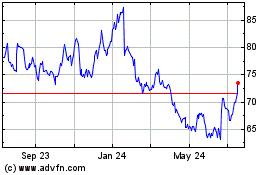UPDATE: Gilead 2Q Net Income Up 4.8% On HIV Drug Sales
July 26 2011 - 6:08PM
Dow Jones News
Gilead Sciences Inc.'s (GILD) second-quarter profit rose 4.8% on
strong sales growth of its HIV drugs, with a benefit from foreign
exchange changes, and the drug maker backed its 2011 sales
projections.
The Foster City, Calif., company's results exceeded Wall Street
expectations, while U.S. sales of its leading HIV drugs were weaker
than projected. Revenue from flu-treatment Tamiflu, sold by partner
Roche Holding AG (RHHBY), continued to drop because
pandemic-related stockpiling has significantly declined.
Shares of Gilead rose slightly in late trading, up 19 cents, to
$42.35. The stock is up 16% since the beginning of the year.
The results come as Gilead is looking to extend its dominance of
the HIV treatment market with the development of a once-daily
four-in-one pill. Data from two major studies of the drug are
expected in the third quarter and will be closely watched on Wall
Street as the market gets increasingly competitive.
Gilead is also seeking approval of a follow-up to Atripla, a
triple combination commonly called "B-tripla" that contains a drug
from Johnson & Johnson (JNJ). A decision from the Food and Drug
Administration is expected in August.
Looking forward, Gilead expects net product sales for 2011 of
$7.9 billion to $8.1 billion. Wall Street currently projects total
revenue for the year of $8.27 billion, which includes revenue from
royalties, contracts and other sources. In 2010, the company
reported product sales of $7.39 billion and revenue of $7.95
billion.
For the three months ended June 30, Gilead reported net income
of $746.2 million, or 93 cents a share, up from $712.1 million, or
79 cents a share, a year ago. Excluding items, per-share earnings
were $1 a share, beating analysts' expectations by a penny,
according to Thomson Reuters.
Revenue climbed dropped 11%, to $2.14 billion, beating a Wall
Street projection of $2.07 billion.
Foreign exchange added $27.3 million to revenue in the quarter,
and $9.7 million to pre-tax earnings, when compared to the year-ago
quarter.
During the quarter, the company repurchased $723.9 million in
stock and had $5.5 billion in cash, cash equivalents, and
marketable securities.
Second-quarter sales of Truvada, which includes two Gilead
drugs, rose 11%, to $711.3 million.
The company's biggest seller, Atripla, a triple treatment of
Truvada with Bristol-Myers Squibb Co.'s (BMY) Sustiva, had sales
rise 15%, to $822 million.
While the total sales of the drugs were strong, ISI analyst Mark
Schoenebaum notes that U.S. sales of the products were actually
below expectations.
U.S. sales of Truvada were $334 million in the period, compared
to a Wall Street expectations of $353 million, according to
Schoenebaum. Atripla sales in the U.S. were $510 million, also
missing projections of $517 million.
Sales of Letairis, a treatment for a rare lung disease, rose
22%, to $73.6 million. In March, the Food and Drug Administration
allowed the removal of a warning about liver injury from the label
of Letairis, a move that was expected to give it a competitive
boost.
Royalty, contract and other revenue from collaborations dropped
19%, to $97.7 million in the quarter, largely because Tamiflu
royalties from Roche fell 39%, to $50.6 million. Tamiflu was
developed by Gilead, which licensed it to Roche.
-By Thomas Gryta, Dow Jones Newswires; 212-416-2169;
thomas.gryta@dowjones.com
Gilead Sciences (NASDAQ:GILD)
Historical Stock Chart
From May 2024 to Jun 2024

Gilead Sciences (NASDAQ:GILD)
Historical Stock Chart
From Jun 2023 to Jun 2024
